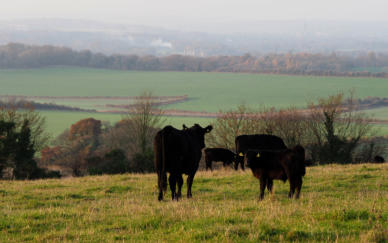





FARM BACKGROUND INFORMATION
Standlynch Farm is situated on land running east-west down to the Avon valley, some five miles south of
Salisbury, and two miles north of Downton. The land is predominantly light, with flints, over chalk. However in
common with other farms in the area, hills are often capped in clay, with gravel underneath. At times only the
gravel may remain, especially on lower rises.
Standlynch as a name features in the Doomesday book, but this relates to the mill and the nearby houses which
then existed, especially on the west side of the river. There was a Roman presence in the area, and finds from
Standlynch Down show that a settlement was present - possibly on the site of older flint workings.
Old field systems can be made out nearby from aerial surveys. The position of the settlement would had offered a
superb viewing point, which can still be appreciated from the public right of way today, looking north to Salisbury,
and south to the Isle of Purbeck.
Now principally an area of cereal production, the landscape has much changed over the decades. Down land
grass was ploughed up at the time of the last war. Every farm at that time would have had a dairy - indeed this
farm had two - but now none remain on this East side of the valley from Downton to Salisbury.
The land in the river valley, some 100 acres (40 Ha's) was laid out as drowned water meadows back in the
seventeenth century. A drowner was employed to control the water in the meadows up until the beginning of the
1970's. Though principally rough grazing now - it is a sad demise of what in its heyday would have been the most
valuable part of the farm. This area has been within the Avon Valley ESA (environmentally sensitive area) since
the start of the scheme. So in 2001/2002, with assistance of grant aid, many of the old ditches - drawings and
drains - of the central part of the system were cleaned out as part of the aims of the scheme to encourage
breeding waders. This resulted in Lapwing successfully breeding in 2002 for the first time in the meadows in 30
years. More recently this land is in an HLS agreement and the ditches have been re-cleaned in accordance with
that agreement.
Standlynch Farm is some 680 acres in size. It is part of land now owned by the Longford estate, seat of the Earl
of Radnor, and was formerly part of the estate given to the Nelson family after Horatio was killed at Trafalgar. The
adjacent Standlynch Manor was renamed Trafalgar House as a result. The Nelson family left in 1947. It is now
privately owned, but now is used for private functions.
My own family became tenants on the Trafalgar estate in the early 1930s with Cyrus Carter, and here at
Standlynch in 1941, firstly my grandfather Arthur, and then his eldest son Gordon. Originally we lived in and used
the farm house and eighteenth century barns at what is now Old Standlynch Farm, but relocated to our current
position in 1998, to what was then known as Home Farm, Trafalgar.














